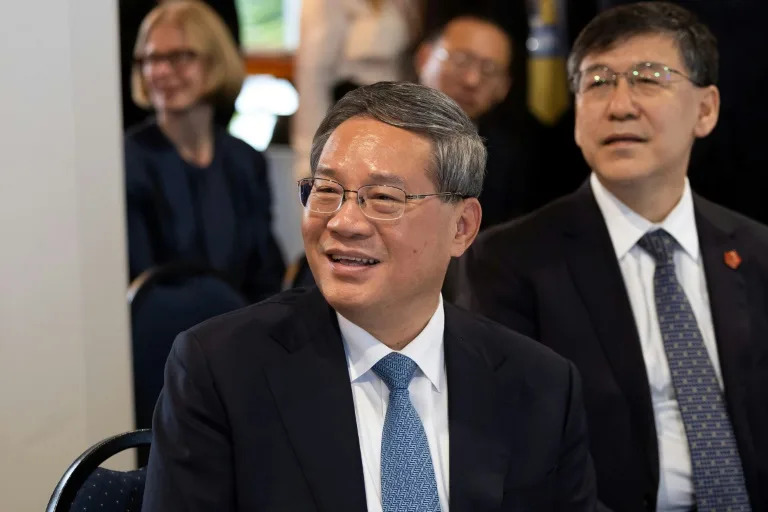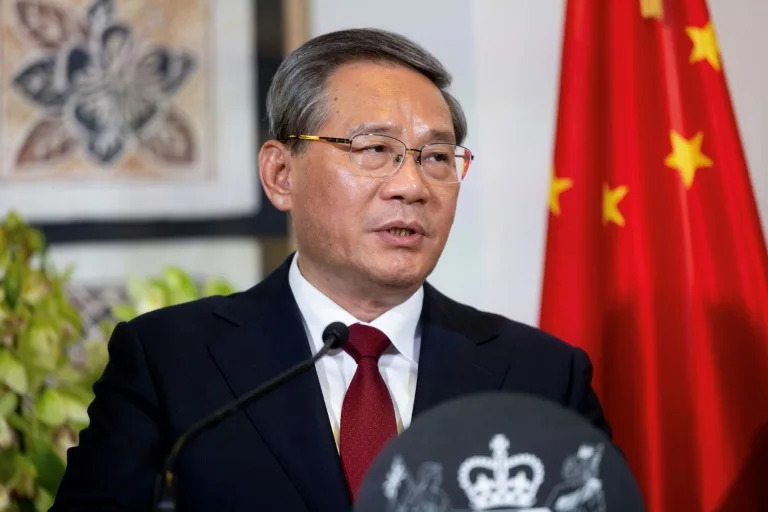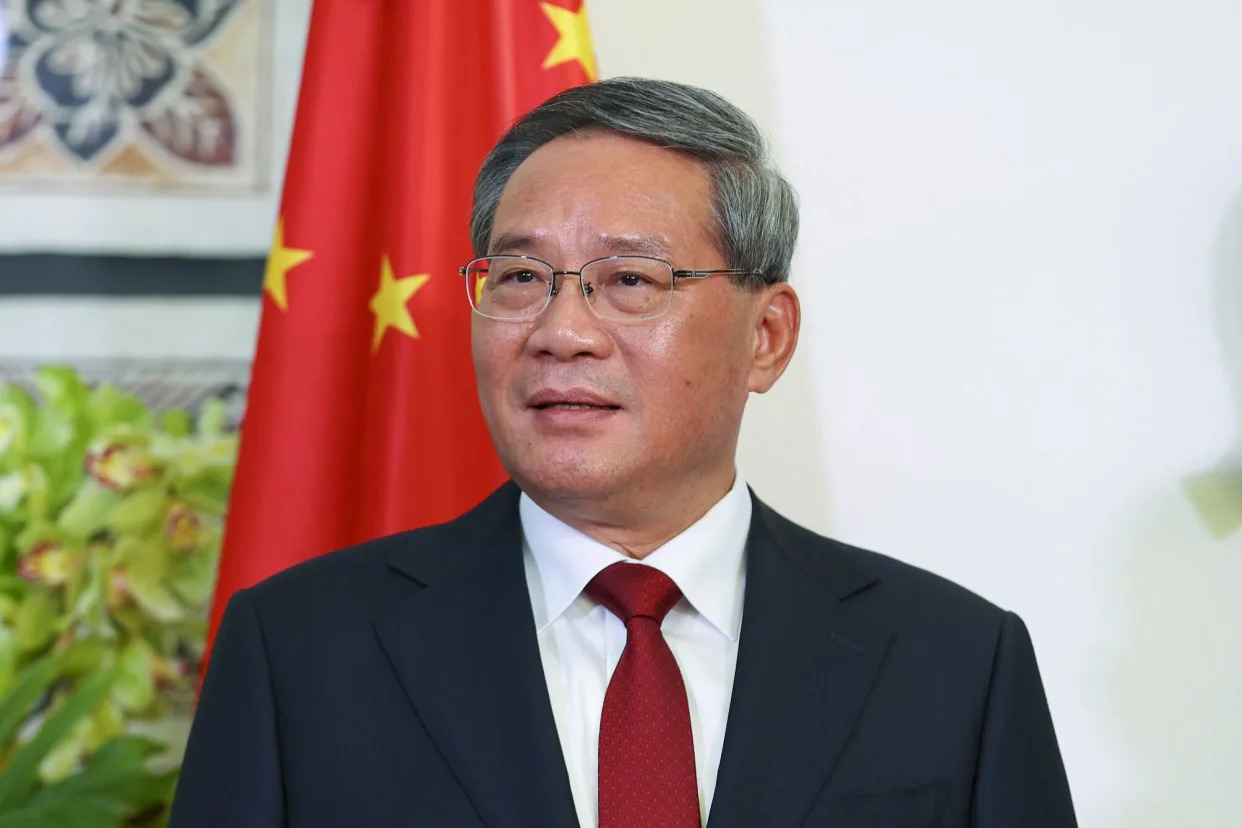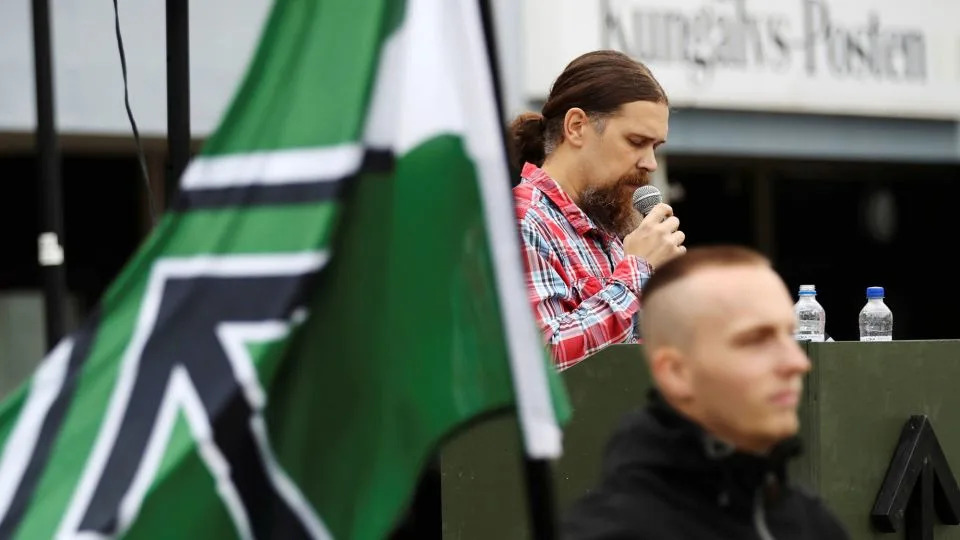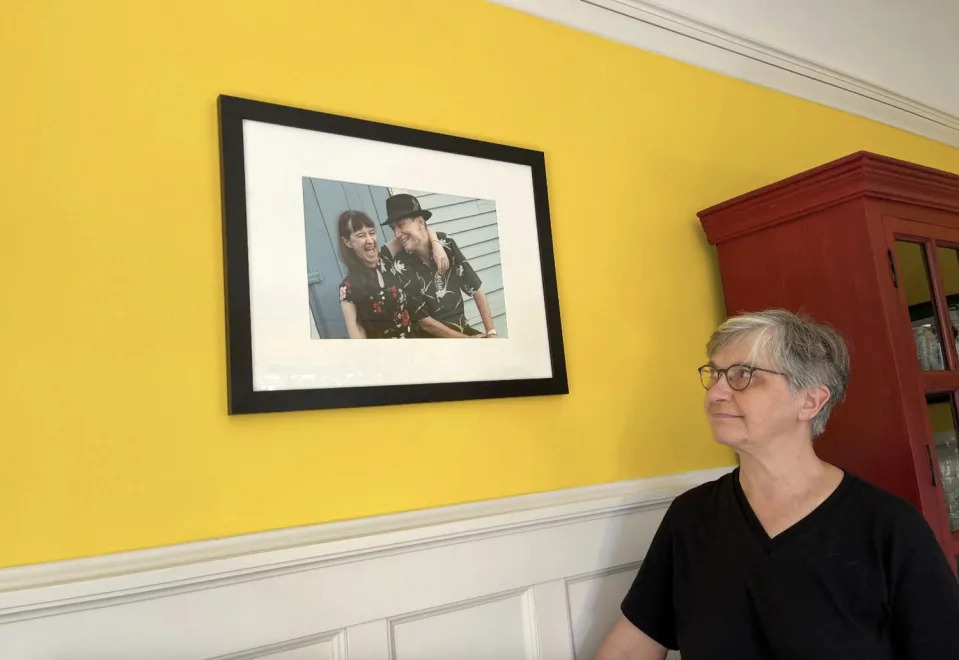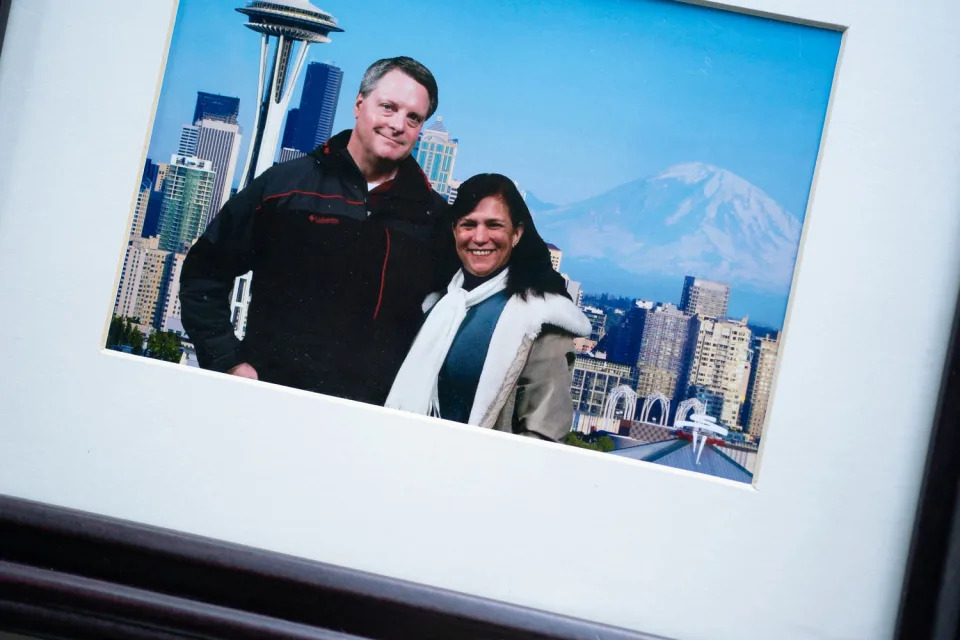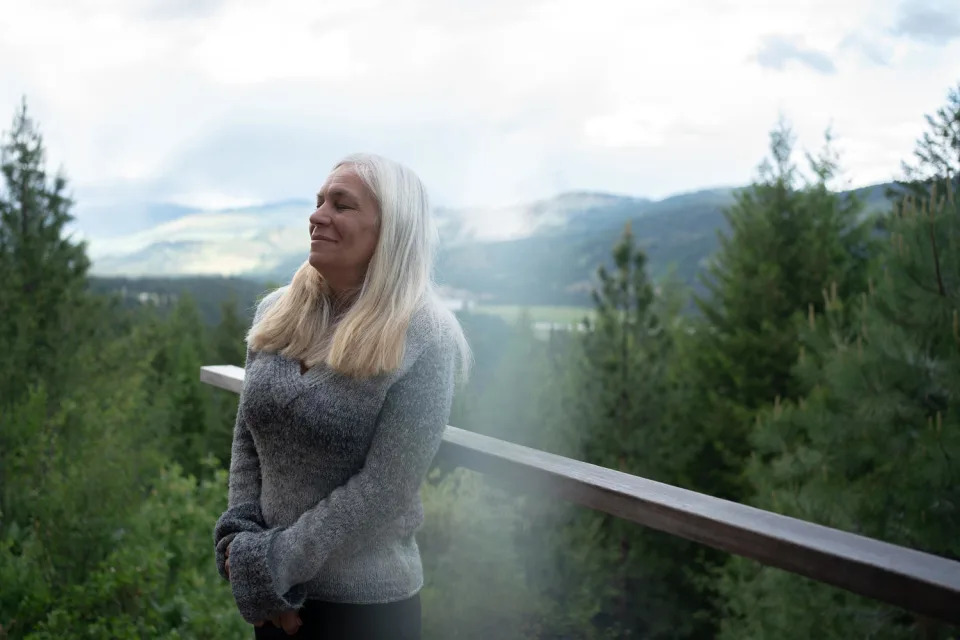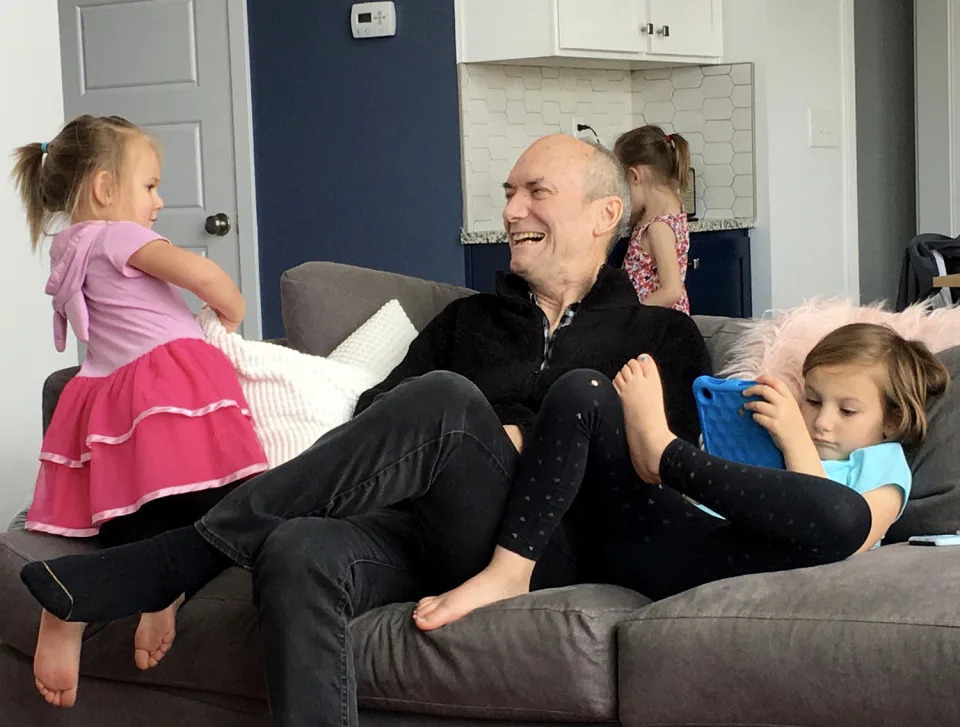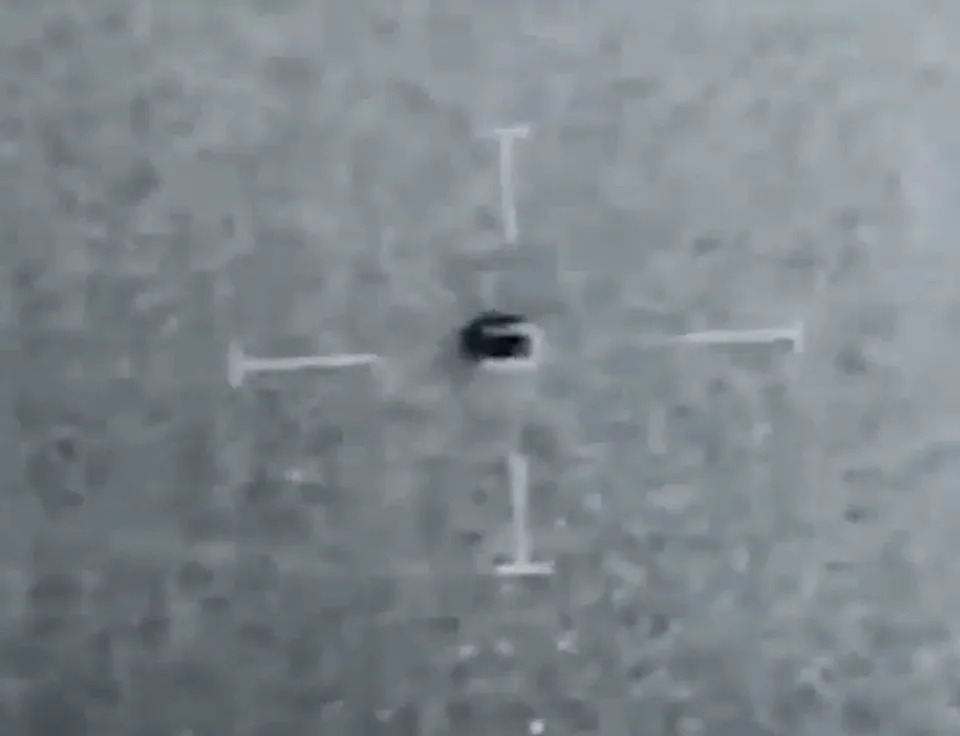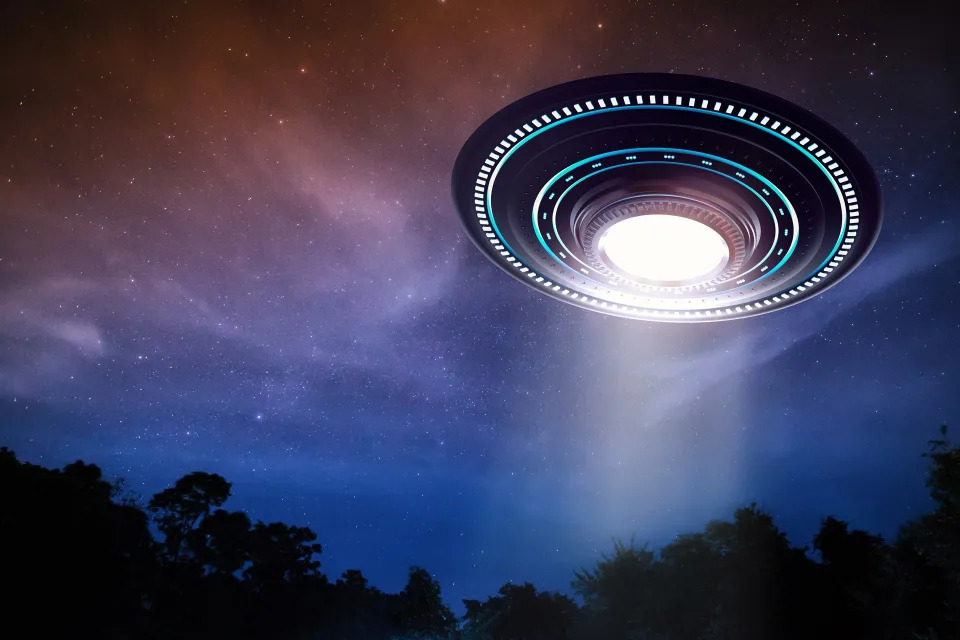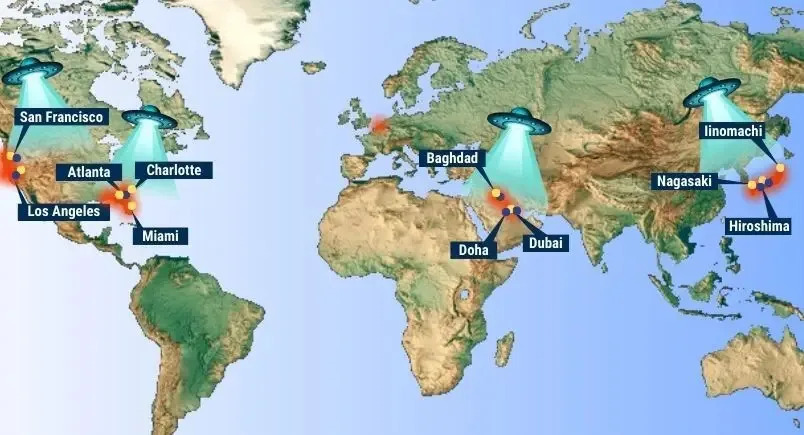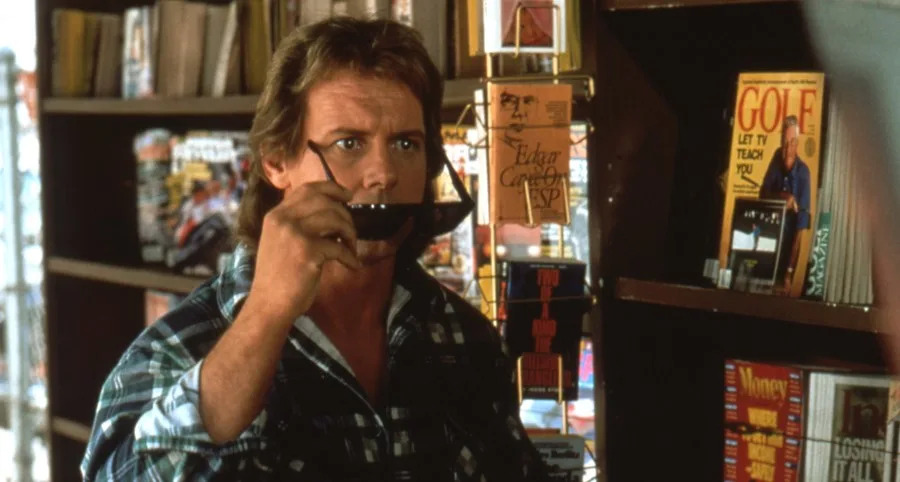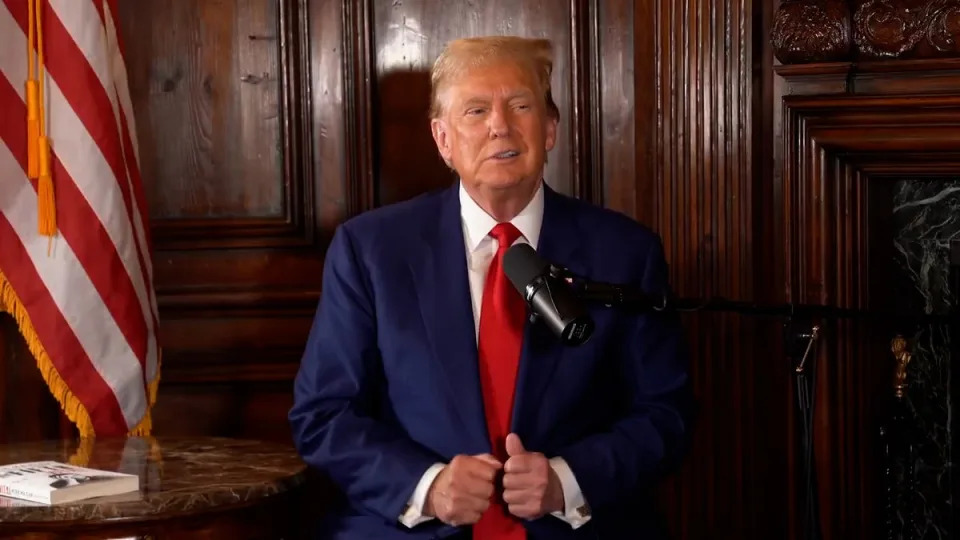Boeing and Airbus may have used 'counterfeit' titanium in planes, FAA say
Patrick Smith and Jay Blackman
Fri, June 14, 2024
Boeing and Airbus, the two biggest commercial airline makers, may have used titanium sold using fake documents, according to evidence from a supplier that has triggered a Federal Aviation Administration investigation.
The FAA said in a statement to NBC News on Friday morning it would look into allegations from Spirit Aerosystems that the two aviation giants used titanium in their planes that came with paperwork verifying its authenticity that could have been falsified.
The news adds to a troubled period for Boeing, which is the subject of ongoing federal investigations for alleged safety problems. But the news also brings its fierce rival, France-headquartered Airbus, into the wider scrutiny the aviation industry is facing.

A plane under construction at an Airbus assembly site (Valentine Chapuis / AFP via Getty Images file)
Spirit Aerosystems, based in Wichita, Kansas, which raised the alarm on the titanium issue, said it acted fast to remove all the suspect titanium from the supply chain.
“This is about titanium that has entered the supply system via documents that have been counterfeited. When this was identified, all suspect parts were quarantined and removed from Spirit production,” the company said in a statement.
Spirit added that “more than 1,000 tests have been completed to confirm the mechanical and metallurgical properties of the affected material to ensure continued airworthiness.”
"Boeing reported a voluntary disclosure to the FAA regarding procurement of material through a distributor who may have falsified or provided incorrect records," the FAA said in a statement confirming yet another investigation into Boeing.
"Boeing issued a bulletin outlining ways suppliers should remain alert to the potential of falsified records," the statement added.
Airbus controls about 60% of the commercial airline market with Boeing taking the remaining 40% — the companies' grip on the industry has been called a duopoly.
Boeing said in an emailed statement: "This industry-wide issue affects some shipments of titanium received by a limited set of suppliers, and tests performed to date have indicated that the correct titanium alloy was used."
Boeing added that it was "removing any affected parts on airplanes prior to delivery. Our analysis shows the in-service fleet can continue to fly safely."
Airbus released a statement saying the company "is aware of the situation."
"Numerous tests have been performed on parts coming from the same source of supply," the statement said. "They show that (aircraft) airworthiness remains intact. The safety and quality of our aircraft are our most important priorities and we are working in close collaboration with our supplier.
Earlier on Friday the FAA said it was investigating how a Boeing 737 Max jet became caught in a so-called “Dutch roll” incident while flying from Phoenix to Oakland last month.
Boeing's tumultuous year began when a door panel blew off a 737 Max-9 mid-air in January.
The FAA is also investigating whether Boeing completed required inspections on its flagship 787 Dreamliner jets.
This article was originally published on NBCNews.com
Boeing, Airbus say planes with titanium parts sold with falsified records are safe
Nick Robertson
Fri, June 14, 2024

(The Hill) – Boeing and Airbus emphasized that there are no safety concerns after revealing Friday that some titanium parts used in their aircraft had falsified documentation, triggering a federal investigation.
Boeing did not say which models of aircraft or how many were affected by the titanium parts, but the company emphasized that it does not believe the discovery impacts safety.
“Our analysis shows the in-service fleet can continue to fly safely,” Boeing said.
Airbus said the parts wound up on its A220 model, a relatively small airliner that is used on shorter routes, but that the model is still airworthy.
“Numerous tests have been performed on parts coming from the same source of supply,” said Airbus, which has its main offices and assembly plant in France. “They show that the A220’s airworthiness remains intact.”
The Federal Aviation Administration (FAA) said it will launch an investigation into how parts without proper documentation were installed on aircraft. Boeing said it will remove the parts from planes that have yet to be delivered to customer airlines.
The FAA is “investigating the scope and impact of the issue,” The Associated Press reported. The agency said Boeing reported the issue with an unnamed distributor “who may have falsified or provided incorrect records.”
Spirit AeroSystems, Boeing’s main manufacturing subsidiary, said titanium parts came with counterfeit paperwork.
“This is about titanium that has entered the supply system via documents that have been counterfeited,” Spirit spokesperson Joe Buccino told the AP. “When this was identified, all suspect parts were quarantined and removed from Spirit production.”
Buccino said more than 1,000 tests have been conducted on the material “to ensure continued airworthiness.”
The investigation, first reported by The New York Times, was sparked when a parts supplier found corrosive damage on titanium parts. Titanium alloy parts are extremely common in aerospace manufacturing, selected for the metal’s strength and heat resistance.
It also comes as Boeing and Spirit are already under intense scrutiny for the manufacturing process of the 737 Max series aircraft. A previous FAA investigation after a door blew out of a flight in January found severe lapses in the company’s safety protocols in manufacturing.
“There are issues around the safety culture in Boeing. Their priorities have been focused on production and not on safety and quality,” FAA Administrator Michael Whitaker said in March. “And so, what we are really focused on now is shifting that focus from production to safety and quality.”
The FAA said its six-week audit of Boeing found “multiple instances when the companies allegedly failed to comply with manufacturing quality control requirements.”
The Associated Press contributed to this article.
Patrick Smith and Jay Blackman
Fri, June 14, 2024
Boeing and Airbus, the two biggest commercial airline makers, may have used titanium sold using fake documents, according to evidence from a supplier that has triggered a Federal Aviation Administration investigation.
The FAA said in a statement to NBC News on Friday morning it would look into allegations from Spirit Aerosystems that the two aviation giants used titanium in their planes that came with paperwork verifying its authenticity that could have been falsified.
The news adds to a troubled period for Boeing, which is the subject of ongoing federal investigations for alleged safety problems. But the news also brings its fierce rival, France-headquartered Airbus, into the wider scrutiny the aviation industry is facing.

A plane under construction at an Airbus assembly site (Valentine Chapuis / AFP via Getty Images file)
Spirit Aerosystems, based in Wichita, Kansas, which raised the alarm on the titanium issue, said it acted fast to remove all the suspect titanium from the supply chain.
“This is about titanium that has entered the supply system via documents that have been counterfeited. When this was identified, all suspect parts were quarantined and removed from Spirit production,” the company said in a statement.
Spirit added that “more than 1,000 tests have been completed to confirm the mechanical and metallurgical properties of the affected material to ensure continued airworthiness.”
"Boeing reported a voluntary disclosure to the FAA regarding procurement of material through a distributor who may have falsified or provided incorrect records," the FAA said in a statement confirming yet another investigation into Boeing.
"Boeing issued a bulletin outlining ways suppliers should remain alert to the potential of falsified records," the statement added.
Airbus controls about 60% of the commercial airline market with Boeing taking the remaining 40% — the companies' grip on the industry has been called a duopoly.
Boeing said in an emailed statement: "This industry-wide issue affects some shipments of titanium received by a limited set of suppliers, and tests performed to date have indicated that the correct titanium alloy was used."
Boeing added that it was "removing any affected parts on airplanes prior to delivery. Our analysis shows the in-service fleet can continue to fly safely."
Airbus released a statement saying the company "is aware of the situation."
"Numerous tests have been performed on parts coming from the same source of supply," the statement said. "They show that (aircraft) airworthiness remains intact. The safety and quality of our aircraft are our most important priorities and we are working in close collaboration with our supplier.
Earlier on Friday the FAA said it was investigating how a Boeing 737 Max jet became caught in a so-called “Dutch roll” incident while flying from Phoenix to Oakland last month.
Boeing's tumultuous year began when a door panel blew off a 737 Max-9 mid-air in January.
The FAA is also investigating whether Boeing completed required inspections on its flagship 787 Dreamliner jets.
This article was originally published on NBCNews.com
Boeing, Airbus say planes with titanium parts sold with falsified records are safe
Nick Robertson
Fri, June 14, 2024

(The Hill) – Boeing and Airbus emphasized that there are no safety concerns after revealing Friday that some titanium parts used in their aircraft had falsified documentation, triggering a federal investigation.
Boeing did not say which models of aircraft or how many were affected by the titanium parts, but the company emphasized that it does not believe the discovery impacts safety.
“Our analysis shows the in-service fleet can continue to fly safely,” Boeing said.
Airbus said the parts wound up on its A220 model, a relatively small airliner that is used on shorter routes, but that the model is still airworthy.
“Numerous tests have been performed on parts coming from the same source of supply,” said Airbus, which has its main offices and assembly plant in France. “They show that the A220’s airworthiness remains intact.”
The Federal Aviation Administration (FAA) said it will launch an investigation into how parts without proper documentation were installed on aircraft. Boeing said it will remove the parts from planes that have yet to be delivered to customer airlines.
The FAA is “investigating the scope and impact of the issue,” The Associated Press reported. The agency said Boeing reported the issue with an unnamed distributor “who may have falsified or provided incorrect records.”
Spirit AeroSystems, Boeing’s main manufacturing subsidiary, said titanium parts came with counterfeit paperwork.
“This is about titanium that has entered the supply system via documents that have been counterfeited,” Spirit spokesperson Joe Buccino told the AP. “When this was identified, all suspect parts were quarantined and removed from Spirit production.”
Buccino said more than 1,000 tests have been conducted on the material “to ensure continued airworthiness.”
The investigation, first reported by The New York Times, was sparked when a parts supplier found corrosive damage on titanium parts. Titanium alloy parts are extremely common in aerospace manufacturing, selected for the metal’s strength and heat resistance.
It also comes as Boeing and Spirit are already under intense scrutiny for the manufacturing process of the 737 Max series aircraft. A previous FAA investigation after a door blew out of a flight in January found severe lapses in the company’s safety protocols in manufacturing.
“There are issues around the safety culture in Boeing. Their priorities have been focused on production and not on safety and quality,” FAA Administrator Michael Whitaker said in March. “And so, what we are really focused on now is shifting that focus from production to safety and quality.”
The FAA said its six-week audit of Boeing found “multiple instances when the companies allegedly failed to comply with manufacturing quality control requirements.”
The Associated Press contributed to this article.
FAA investigating titanium used in some Boeing, Airbus jets
Updated Fri, June 14, 2024

By David Shepardson
WASHINGTON (Reuters) -The U.S. Federal Aviation Administration is investigating whether false or incorrect documents were used to verify the authenticity of titanium used in some recently manufactured Boeing jets, the agency said.
The New York Times, which first reported the issue on Friday, said the FAA is also investigating the authenticity of documents for titanium used in some Airbus jets.
Aircraft manufacturers are facing strong demand for new planes due to a surge in post-pandemic travel. However, supply-chain problems and component shortages are limiting their ability to meet this demand.
Titanium is an important component in the aerospace supply chain and is used to make landing gears, blades and turbine discs for aircraft.
The FAA said Boeing reported a voluntary disclosure "regarding procurement of material through a distributor who may have falsified or provided incorrect records."
The agency added: "Boeing issued a bulletin outlining ways suppliers should remain alert to the potential of falsified records."
Boeing said the issue involves the broader industry and some titanium shipments received by a limited set of suppliers, affecting a small number of airplane parts.
The planemaker said it was removing any such parts from airplanes prior to delivery and added there is no impact to safety.
Airbus said it was aware of the reports but said "numerous tests have been performed on parts coming from the same source of supply. They show that the A220’s airworthiness remains intact."
Canada has imposed sanctions on Russian titanium, albeit with exceptions. It was not clear if the false documents were connected to sanctions.
Spirit AeroSystems, which supplies fuselages for Boeing and wings for Airbus, said the titanium entered the supply chain with "counterfeited" documents, and all related parts have been removed from its production.
"More than 1,000 tests have been completed to confirm the mechanical and metallurgical properties of the affected material to ensure continued airworthiness," Spirit said.
Last year, jet engine manufacturer CFM International disclosed that thousands of its engine components might have been sold with falsified documentation by a British distributor.
The discovery had prompted airlines to change parts on a handful of planes.
Boeing shares fell 1.8%, while Spirit shares were down about 1%.
(Reporting by Shivansh Tiwary in Bengaluru and David Shepardson in Washington; Editing by Toby Chopra, Rod Nickel and Nick Zieminski)

Engineless Boeing 737 MAX jets await their fate as the company's 737 factory looms behind them in Renton, WA
FAA investigating how titanium parts with falsified records wound up in Boeing and Airbus planes
DAVID KOENIG
Updated Fri, June 14, 2024

FILE - An Airbus A220 lands at Toulouse-Blagnac airport, July 10, 2018, in southwestern France. Federal regulators are investigating how parts made with counterfeit titanium wound up in some Boeing and Airbus passenger jets that were built in recent years. Boeing and Airbus said Friday, June 14, 2024, that planes containing the parts are safe to fly. (AP Photo/Frederic Scheiber, File)More
Federal regulators are investigating how parts made with titanium that was sold with falsified quality documentation wound up in Boeing and Airbus passenger jets that were built in recent years.
Boeing and Airbus said Friday that planes containing the parts are safe to fly, but Boeing said it was removing affected parts from planes that haven’t been delivered yet to airline customers.
It will be up to regulators including the Federal Aviation Administration to decide whether any work needs to be done to planes that are already carrying passengers.
The FAA said it is “investigating the scope and impact of the issue.” The agency said Boeing reported the problem covering material from a distributor “who may have falsified or provided incorrect records.” The FAA did not name the distributor.
Boeing and Airbus declined to say how many planes were flying with parts made from the undocumented titanium.
Spirit AeroSystems, which makes fuselages for Boeing planes and wings for Airbus jets, reported the falsified documents.
“This is about titanium that has entered the supply system via documents that have been counterfeited," Spirit spokesperson Joe Buccino said. “When this was identified, all suspect parts were quarantined and removed from Spirit production.”
Buccino said more than 1,000 tests have been conducted on the material "to ensure continued airworthiness.”
The New York Times first reported the FAA investigation. The newspaper said a parts supplier found small holes in the material from corrosion.
The aerospace supply chain is a global one. The titanium came from a supplier in China starting around 2019 and was sold to several companies that make components that Spirit Aerosystems uses in its work for Boeing and Airbus, according to two people familiar with the situation. They spoke to The Associated Press on condition of anonymity to discuss the ongoing investigation.
The New York Times reported that an Italian company, Titanium International Group, noticed that the material looked different from previous supplies and determined that paperwork accompanying the titanium seemed inauthentic. A general manager told the newspaper that the company was cooperating with authorities and could not provide additional information.
The paperwork, called a statement of conformity, describes the part or material, how it was made and where it comes from. It is designed to ensure that parts comply with FAA standards for quality.
Titanium alloys have been used for decades in aircraft production because of their light weight, strength and resistance to corrosion and high temperatures. They are used in airframes, landing gear and other parts.
Boeing said tests indicate that the parts were made from the correct titanium alloy, which raised questions about why the documentation was falsified. The company, based in Arlington, Virginia, said it buys most of the titanium it uses directly from other sources, and that supply is not affected by the documentation issue.
Boeing said it was removing affected parts on planes before delivering them to airlines. “Our analysis shows the in-service fleet can continue to fly safely,” the company said. It did not say which of its aircraft models were affected.
Airbus said the parts wound up on one of its models, the A220, a relatively small airliner that is used on shorter routes.
“Numerous tests have been performed on parts coming from the same source of supply,” said Airbus, which has its main offices and assembly plant in France. “They show that the A220’s airworthiness remains intact.”
Officials said the affected parts could be replaced when planes undergo scheduled maintenance checks. It would be up to the FAA and its European counterpart to decide whether to order airlines to replace the parts sooner.
FAA is investigating how Boeing, Airbus jets may have ended up with counterfeit titanium. Here's a timeline of the company's mounting problems.
Plus, the FAA is also probing a "Dutch roll" incident.
Katie Mather
·Internet Culture Reporter
Updated Fri, June 14, 2024

The Federal Aviation Administration has opened two more investigations into Boeing. The first probe was prompted by an incident in which a 737 Max experienced a rare event known as a "Dutch roll," and the second, which also involves Airbus planes, follows a report that counterfeit titanium may have been used in some jet parts.
Boeing has faced heightened scrutiny since the start of 2024, with Congress calling on top executives to testify at a Senate hearing in mid-April over whether the company’s corporate culture prioritized money-saving measures over safety in its production of the 787 Dreamliner and the 777 aircraft.
🚨 What just happened?
In May, a Southwest flight from Phoenix to Oakland, Calif., experienced a Dutch roll at 32,000 feet midflight. A Dutch roll is when a plane’s tail slides and the aircraft starts rocking from side to side simultaneously, which impacts the plane’s stability, potentially throwing the aircraft off course or making it too difficult to turn. It is a rare situation, but pilots are trained on how to recover from it.
The May 25 flight did not result in any injuries to the passengers or crew.
An early report by the FAA found that there was damage to a unit that provides the backup power to the rudder, which controls the plane’s rotation and stability.
Separately, the New York Times reported on June 14 that a recent investigation by supplier Spirit AeroSystems found that counterfeit titanium, sold with falsified documents, was used to build parts for Boeing and Airbus jets. It is unclear how many planes may have parts made of counterfeit titanium and how it may affect the structural integrity of those aircraft.
Boeing has responded that most of its plane materials have been tested and remain unaffected. The aircraft that allegedly have components made with the material were built between 2019 and 2023 and include some Boeing 737 Max and 787 Dreamliner planes.
🗓️ Let’s rewind. How did we end up here?
May 2024
The Seattle Times reports a second Boeing whistleblower died after spending two weeks in the hospital from a sudden infection. Joshua Dean accused Boeing supplier Spirit AeroSystems of ignoring manufacturing defects on the Boeing 737 Max model before being fired in 2023.
April 2024
FAA announces investigation into near-miss incident at LaGuardia Airport involving Southwest Airlines 737 on March 23.
Southwest Airlines Boeing 737 makes an emergency landing at Preston Smith International Airport after a small fire in the left engine.
Boeing pays Alaska Airlines $160 million to make up for losses the airline suffered following the mid-flight door plug blowout.
FAA announces investigation into claims made by new Boeing whistleblower, Sam Salehpour, an engineer who had worked on the 787 and 777 aircraft. He alleged that the planes were improperly fastened together and he was worried that after years of use, the planes could break apart mid-flight.
United Airlines claims the emergency grounding of the Boeing 737 Max 9 jetliner cost the company $200 million in the first three months of the year.
In a Senate hearing, lawmakers called multiple aviation safety specialists and former Boeing employees to testify. Witness Sam Salehpour, a quality engineer at Boeing, alleged that the company had ignored all of the issues he’d flagged with the 787 aircraft and that he was “subjected to threats of violence from my supervisor” after he spoke out.
Read more from the Associated Press: Boeing put under Senate scrutiny during back-to-back hearings on aircraft maker's safety culture
March 2024
The FBI is investigating the Alaska Airlines flight in January in which a door plug blew off the plane midflight — and has told passengers they may be “a possible victim of a crime.”
The FAA’s 737 Max production audit finds multiple instances in which Boeing allegedly did not comply with manufacturing quality control requirements.
In two separate incidents, a Boeing 777-200 loses a wheel during takeoff from San Francisco and a Boeing 737 skids off the runway after landing in Houston.
The next week, a prominent Boeing whistleblower — former employee John Barnett — dies by suicide while in Charleston, S.C., for a deposition for a lawsuit against Boeing.
A Boeing 787 Dreamliner nosedives during a flight from Sydney to Auckland, New Zealand, injuring at least 50 people, on the same day a Boeing 777 flight from Sydney is forced to turn around due to a maintenance issue.
Another Boeing 777 is forced to make an emergency landing at Los Angeles International Airport after pilots report a flat tire.
A Boeing 737 that took off from San Francisco later that week is found to be missing a panel during a postflight inspection.
Boeing sues Virgin Galactic, accusing it of stealing trade secrets.
Boeing CEO Dave Calhoun announces he will be stepping down by the end of the year. The CEO of Boeing Commercial Airplanes, Stan Deal, is retiring and Boeing’s chairman, Larry Kellner, will not be seeking reelection as a board director.
A United Airlines Boeing 777 flight from San Francisco to Paris was diverted to Denver due to an engine issue.
A United Airlines Boeing 787 plane headed to Newark, N.J., from Tel Aviv, Israel, was forced to make an emergency landing at New York Stewart International Airport because of extreme turbulence. Seven passengers were taken to the hospital and 15 were treated on-site for injuries.
An Alaska Airlines Boeing 737 Max 9 jet from Honolulu to Anchorage, Alaska, was forced to turn back after a malfunctioning bathroom sink flooded the cabin.
Whistleblowers, nosedives and a DOJ investigation: Read more about Boeing’s March mishaps on Yahoo News
February 2024
The NTSB publishes a preliminary report that found the Alaska Airlines flight was missing four key bolts, which is why the door plug blew out.
January 2024
Alaska Airlines Flight 1282 experiences a door plug blowout midflight. The FAA subsequently grounds all Max 9 aircraft to investigate.
Read more from BBC News: Passenger describes being on Alaska Airlines Flight 1282
December 2023
Boeing urges airlines to inspect all 737 Max jets for potential loose hardware in the plane’s rudder control systems.
August 2023
Boeing reports a supplier quality issue with 737 Max planes involving improperly drilled holes.
October 2022
The FAA tells Boeing that some documents submitted for the certification review of the 737 Max 7 are incomplete.
March 2021
China’s aviation regulator claims there are major safety concerns with the Boeing Max jets.
November 2020
The FAA allows Boeing 737 Max planes to fly again.
September 2020
An 18-month-long investigation by a House of Representatives panel concludes that Boeing failed in its design and development of the Max aircraft and was not fully transparent with the FAA.
Read more from Reuters: U.S. lawmakers fault FAA, Boeing for deadly 737 Max crashes
January 2020
Boeing suspends all 737 production.
⚖️ Boeing has had problems for years. Why is it being investigated now?
“We’ve known [about Boeing] for five years,” Mark Pegram, father of one of the Ethiopian Airlines flight victims, told NPR in March. “I think the rest of the world is finally waking up to it, that these weren’t just isolated incidents.”
Boeing has paid billions of dollars in settlements since 2018, and the company and its leaders entered into a deferred prosecution agreement in January 2021 with the Department of Justice that has so far helped them avoid criminal prosecution.
Boeing paid $1.77 billion to compensate airline customers, $243.6 million as a criminal fine and $500 million for a compensation fund for family members of crash victims, CNN reported.
A yearlong FAA-commissioned panel review was critical of the safety culture at Boeing, and found that executives and employees were not aligned with what the safety standards were, according to a report released in February. The investigation also found that many employees were afraid of retaliation for speaking up.
FAA chief admits agency was ‘too hands-off’ before Boeing door blowout
Nick Robertson
Thu, June 13, 2024

The head of the Federal Aviation Administration (FAA) said Thursday the agency was “too hands-off” with regulating aircraft manufacturers before a door blew out of a Boeing plane in January, causing weeks of scrutiny into the company’s manufacturing safety.
FAA Administrator Michael Whitaker said in a Senate Commerce Committee hearing about Boeing that his agency “should have had much better visibility” into Boeing’s manufacturing process.
“FAA’s approach was too hands-off, too focused on paperwork audits, and not focused enough on inspections,” he said. “We have changed that approach over the last several months, and those changes are permanent. We have now moved to a more active, comprehensive oversight model, the audit plus inspection model, which allows the FAA to have much better insight into Boeing’s operations.”
The door blowout of a Boeing 737 Max operated by Alaska Airlines, caused by missing bolts, resulted in the grounding of every similar aircraft in the country and mandatory inspections. An investigation into Boeing’s process found a lax safety culture and oversights during manufacturing.
“There are issues around the safety culture in Boeing. Their priorities have been focused on production and not on safety and quality,” Whittaker said in March. “And so, what we are really focused on now is shifting that focus from production to safety and quality.”
The FAA said its six-week audit of Boeing found “multiple instances when the companies allegedly failed to comply with manufacturing quality control requirements.”
The scrutiny has tanked the company’s stock and brought additional scrutiny from Congress. The Justice Department launched a criminal investigation in March, and members of the Senate Commerce Committee have previously promised more oversight.
Sen. Ted Cruz (R-Texas), the committee’s ranking member, said in March more oversight is “unquestionably” needed.
“This is an ongoing issue. Obviously, what has happened with Boeing in recent months is deeply concerning. The NTSB is engaged in investigation dealing with the Alaska Airlines incident. That investigation needs to proceed to conclusion,” he told The Hill.
“The challenges we’ve seen recently have raised real and material concerns and concerns that need to be addressed.”
DAVID KOENIG
Updated Fri, June 14, 2024

FILE - An Airbus A220 lands at Toulouse-Blagnac airport, July 10, 2018, in southwestern France. Federal regulators are investigating how parts made with counterfeit titanium wound up in some Boeing and Airbus passenger jets that were built in recent years. Boeing and Airbus said Friday, June 14, 2024, that planes containing the parts are safe to fly. (AP Photo/Frederic Scheiber, File)More
Federal regulators are investigating how parts made with titanium that was sold with falsified quality documentation wound up in Boeing and Airbus passenger jets that were built in recent years.
Boeing and Airbus said Friday that planes containing the parts are safe to fly, but Boeing said it was removing affected parts from planes that haven’t been delivered yet to airline customers.
It will be up to regulators including the Federal Aviation Administration to decide whether any work needs to be done to planes that are already carrying passengers.
The FAA said it is “investigating the scope and impact of the issue.” The agency said Boeing reported the problem covering material from a distributor “who may have falsified or provided incorrect records.” The FAA did not name the distributor.
Boeing and Airbus declined to say how many planes were flying with parts made from the undocumented titanium.
Spirit AeroSystems, which makes fuselages for Boeing planes and wings for Airbus jets, reported the falsified documents.
“This is about titanium that has entered the supply system via documents that have been counterfeited," Spirit spokesperson Joe Buccino said. “When this was identified, all suspect parts were quarantined and removed from Spirit production.”
Buccino said more than 1,000 tests have been conducted on the material "to ensure continued airworthiness.”
The New York Times first reported the FAA investigation. The newspaper said a parts supplier found small holes in the material from corrosion.
The aerospace supply chain is a global one. The titanium came from a supplier in China starting around 2019 and was sold to several companies that make components that Spirit Aerosystems uses in its work for Boeing and Airbus, according to two people familiar with the situation. They spoke to The Associated Press on condition of anonymity to discuss the ongoing investigation.
The New York Times reported that an Italian company, Titanium International Group, noticed that the material looked different from previous supplies and determined that paperwork accompanying the titanium seemed inauthentic. A general manager told the newspaper that the company was cooperating with authorities and could not provide additional information.
The paperwork, called a statement of conformity, describes the part or material, how it was made and where it comes from. It is designed to ensure that parts comply with FAA standards for quality.
Titanium alloys have been used for decades in aircraft production because of their light weight, strength and resistance to corrosion and high temperatures. They are used in airframes, landing gear and other parts.
Boeing said tests indicate that the parts were made from the correct titanium alloy, which raised questions about why the documentation was falsified. The company, based in Arlington, Virginia, said it buys most of the titanium it uses directly from other sources, and that supply is not affected by the documentation issue.
Boeing said it was removing affected parts on planes before delivering them to airlines. “Our analysis shows the in-service fleet can continue to fly safely,” the company said. It did not say which of its aircraft models were affected.
Airbus said the parts wound up on one of its models, the A220, a relatively small airliner that is used on shorter routes.
“Numerous tests have been performed on parts coming from the same source of supply,” said Airbus, which has its main offices and assembly plant in France. “They show that the A220’s airworthiness remains intact.”
Officials said the affected parts could be replaced when planes undergo scheduled maintenance checks. It would be up to the FAA and its European counterpart to decide whether to order airlines to replace the parts sooner.
FAA is investigating how Boeing, Airbus jets may have ended up with counterfeit titanium. Here's a timeline of the company's mounting problems.
Plus, the FAA is also probing a "Dutch roll" incident.
Katie Mather
·Internet Culture Reporter
Updated Fri, June 14, 2024
The Federal Aviation Administration has opened two more investigations into Boeing. The first probe was prompted by an incident in which a 737 Max experienced a rare event known as a "Dutch roll," and the second, which also involves Airbus planes, follows a report that counterfeit titanium may have been used in some jet parts.
Boeing has faced heightened scrutiny since the start of 2024, with Congress calling on top executives to testify at a Senate hearing in mid-April over whether the company’s corporate culture prioritized money-saving measures over safety in its production of the 787 Dreamliner and the 777 aircraft.
🚨 What just happened?
In May, a Southwest flight from Phoenix to Oakland, Calif., experienced a Dutch roll at 32,000 feet midflight. A Dutch roll is when a plane’s tail slides and the aircraft starts rocking from side to side simultaneously, which impacts the plane’s stability, potentially throwing the aircraft off course or making it too difficult to turn. It is a rare situation, but pilots are trained on how to recover from it.
The May 25 flight did not result in any injuries to the passengers or crew.
An early report by the FAA found that there was damage to a unit that provides the backup power to the rudder, which controls the plane’s rotation and stability.
Separately, the New York Times reported on June 14 that a recent investigation by supplier Spirit AeroSystems found that counterfeit titanium, sold with falsified documents, was used to build parts for Boeing and Airbus jets. It is unclear how many planes may have parts made of counterfeit titanium and how it may affect the structural integrity of those aircraft.
Boeing has responded that most of its plane materials have been tested and remain unaffected. The aircraft that allegedly have components made with the material were built between 2019 and 2023 and include some Boeing 737 Max and 787 Dreamliner planes.
🗓️ Let’s rewind. How did we end up here?
May 2024
The Seattle Times reports a second Boeing whistleblower died after spending two weeks in the hospital from a sudden infection. Joshua Dean accused Boeing supplier Spirit AeroSystems of ignoring manufacturing defects on the Boeing 737 Max model before being fired in 2023.
April 2024
FAA announces investigation into near-miss incident at LaGuardia Airport involving Southwest Airlines 737 on March 23.
Southwest Airlines Boeing 737 makes an emergency landing at Preston Smith International Airport after a small fire in the left engine.
Boeing pays Alaska Airlines $160 million to make up for losses the airline suffered following the mid-flight door plug blowout.
FAA announces investigation into claims made by new Boeing whistleblower, Sam Salehpour, an engineer who had worked on the 787 and 777 aircraft. He alleged that the planes were improperly fastened together and he was worried that after years of use, the planes could break apart mid-flight.
United Airlines claims the emergency grounding of the Boeing 737 Max 9 jetliner cost the company $200 million in the first three months of the year.
In a Senate hearing, lawmakers called multiple aviation safety specialists and former Boeing employees to testify. Witness Sam Salehpour, a quality engineer at Boeing, alleged that the company had ignored all of the issues he’d flagged with the 787 aircraft and that he was “subjected to threats of violence from my supervisor” after he spoke out.
Read more from the Associated Press: Boeing put under Senate scrutiny during back-to-back hearings on aircraft maker's safety culture
March 2024
The FBI is investigating the Alaska Airlines flight in January in which a door plug blew off the plane midflight — and has told passengers they may be “a possible victim of a crime.”
The FAA’s 737 Max production audit finds multiple instances in which Boeing allegedly did not comply with manufacturing quality control requirements.
In two separate incidents, a Boeing 777-200 loses a wheel during takeoff from San Francisco and a Boeing 737 skids off the runway after landing in Houston.
The next week, a prominent Boeing whistleblower — former employee John Barnett — dies by suicide while in Charleston, S.C., for a deposition for a lawsuit against Boeing.
A Boeing 787 Dreamliner nosedives during a flight from Sydney to Auckland, New Zealand, injuring at least 50 people, on the same day a Boeing 777 flight from Sydney is forced to turn around due to a maintenance issue.
Another Boeing 777 is forced to make an emergency landing at Los Angeles International Airport after pilots report a flat tire.
A Boeing 737 that took off from San Francisco later that week is found to be missing a panel during a postflight inspection.
Boeing sues Virgin Galactic, accusing it of stealing trade secrets.
Boeing CEO Dave Calhoun announces he will be stepping down by the end of the year. The CEO of Boeing Commercial Airplanes, Stan Deal, is retiring and Boeing’s chairman, Larry Kellner, will not be seeking reelection as a board director.
A United Airlines Boeing 777 flight from San Francisco to Paris was diverted to Denver due to an engine issue.
A United Airlines Boeing 787 plane headed to Newark, N.J., from Tel Aviv, Israel, was forced to make an emergency landing at New York Stewart International Airport because of extreme turbulence. Seven passengers were taken to the hospital and 15 were treated on-site for injuries.
An Alaska Airlines Boeing 737 Max 9 jet from Honolulu to Anchorage, Alaska, was forced to turn back after a malfunctioning bathroom sink flooded the cabin.
Whistleblowers, nosedives and a DOJ investigation: Read more about Boeing’s March mishaps on Yahoo News
February 2024
The NTSB publishes a preliminary report that found the Alaska Airlines flight was missing four key bolts, which is why the door plug blew out.
January 2024
Alaska Airlines Flight 1282 experiences a door plug blowout midflight. The FAA subsequently grounds all Max 9 aircraft to investigate.
Read more from BBC News: Passenger describes being on Alaska Airlines Flight 1282
December 2023
Boeing urges airlines to inspect all 737 Max jets for potential loose hardware in the plane’s rudder control systems.
August 2023
Boeing reports a supplier quality issue with 737 Max planes involving improperly drilled holes.
October 2022
The FAA tells Boeing that some documents submitted for the certification review of the 737 Max 7 are incomplete.
March 2021
China’s aviation regulator claims there are major safety concerns with the Boeing Max jets.
November 2020
The FAA allows Boeing 737 Max planes to fly again.
September 2020
An 18-month-long investigation by a House of Representatives panel concludes that Boeing failed in its design and development of the Max aircraft and was not fully transparent with the FAA.
Read more from Reuters: U.S. lawmakers fault FAA, Boeing for deadly 737 Max crashes
January 2020
Boeing suspends all 737 production.
⚖️ Boeing has had problems for years. Why is it being investigated now?
“We’ve known [about Boeing] for five years,” Mark Pegram, father of one of the Ethiopian Airlines flight victims, told NPR in March. “I think the rest of the world is finally waking up to it, that these weren’t just isolated incidents.”
Boeing has paid billions of dollars in settlements since 2018, and the company and its leaders entered into a deferred prosecution agreement in January 2021 with the Department of Justice that has so far helped them avoid criminal prosecution.
Boeing paid $1.77 billion to compensate airline customers, $243.6 million as a criminal fine and $500 million for a compensation fund for family members of crash victims, CNN reported.
A yearlong FAA-commissioned panel review was critical of the safety culture at Boeing, and found that executives and employees were not aligned with what the safety standards were, according to a report released in February. The investigation also found that many employees were afraid of retaliation for speaking up.
FAA chief admits agency was ‘too hands-off’ before Boeing door blowout
Nick Robertson
Thu, June 13, 2024

The head of the Federal Aviation Administration (FAA) said Thursday the agency was “too hands-off” with regulating aircraft manufacturers before a door blew out of a Boeing plane in January, causing weeks of scrutiny into the company’s manufacturing safety.
FAA Administrator Michael Whitaker said in a Senate Commerce Committee hearing about Boeing that his agency “should have had much better visibility” into Boeing’s manufacturing process.
“FAA’s approach was too hands-off, too focused on paperwork audits, and not focused enough on inspections,” he said. “We have changed that approach over the last several months, and those changes are permanent. We have now moved to a more active, comprehensive oversight model, the audit plus inspection model, which allows the FAA to have much better insight into Boeing’s operations.”
The door blowout of a Boeing 737 Max operated by Alaska Airlines, caused by missing bolts, resulted in the grounding of every similar aircraft in the country and mandatory inspections. An investigation into Boeing’s process found a lax safety culture and oversights during manufacturing.
“There are issues around the safety culture in Boeing. Their priorities have been focused on production and not on safety and quality,” Whittaker said in March. “And so, what we are really focused on now is shifting that focus from production to safety and quality.”
The FAA said its six-week audit of Boeing found “multiple instances when the companies allegedly failed to comply with manufacturing quality control requirements.”
The scrutiny has tanked the company’s stock and brought additional scrutiny from Congress. The Justice Department launched a criminal investigation in March, and members of the Senate Commerce Committee have previously promised more oversight.
Sen. Ted Cruz (R-Texas), the committee’s ranking member, said in March more oversight is “unquestionably” needed.
“This is an ongoing issue. Obviously, what has happened with Boeing in recent months is deeply concerning. The NTSB is engaged in investigation dealing with the Alaska Airlines incident. That investigation needs to proceed to conclusion,” he told The Hill.
“The challenges we’ve seen recently have raised real and material concerns and concerns that need to be addressed.”
